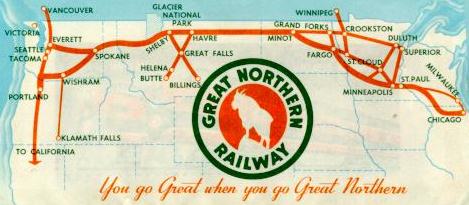The Free Market and the Great Northern Railroad
The Great Northern Railway was the only transcontinental railroad that never went bankrupt. It also was the only transcontinental railroad that never accepted any government subsidies. The Union Pacific and Central Pacific railroads that were constructed in 1862 were receiving $16,000-$48,000 from congress per mile constructed, and were thus built as quickly, and cheaply as possible and often followed circuitous routes just to collect further subsidies by extending the length of the line. After the UP and CP rail-lines were constructed, they had to be rebuilt and relocated for the next 5 years and costs ballooned up to 3x what they budgeted when they went before congress begging for money. Some members of Congress and the Senate were bribed with free stocks, fancy dinners, and nights out with an entire orchestra and magician just for a small group of senators. And despite being given a mountain of taxpayer money, both rail lines went bankrupt in 30 years. In contrast, the GN railway was funded entirely by James J. Hill, a steamship worker and fur trader who saved his money, invested and partnered with 4 other men to buy several bankrupt rail lines.

They then spent 8 years connecting lines they had purchased in Minnesota with the west coast. Cutting waste and excess at every step of the way to build as short of a line as possible with as few curves as possible. He even hired a man to spend months searching for a lost pass through the Montana Rockies that Lewis and Clark had described but was assumed to be a myth by the general population and most explorers of the time. When he found the pass, it shortened his route by 100 miles, and when completed it was touted as the best constructed and most profitable railway in the world, and Hill's cost cutting measures during construction also made the rail line affordable, to the point where a transcontinental ticket was $10 ($250 in today's money), which was unheard of back then. The rail line operated all the way until 1970 when it merged with another line.

The tracks are still operational to this day, and the company never went bankrupt. Free markets, and free exchange are a powerful tool for creation and improvement of society while government force and subsidies are a powerful tool for destruction and impoverishment of society. Trump has put forth a rather extensive infrastructure plan, and while I support the construction of infrastructure, the taint of stolen tax money being used to fund it will ultimately poison any project. Most infrastructure is not profitable due to the waste and largess that government money encourages. Only when the same people overseeing construction are simultaneously risking their own money is there ever a concern for efficiency. This inherent flaw of government spending will inevitably doom any public infrastructure to debt, and ballooning costs. Private investment with the goal of turning a profit through voluntary interactions is the only way any endeavour shall turn out as good for society.